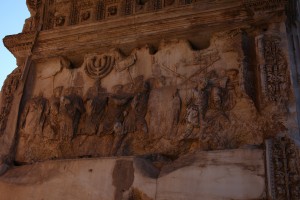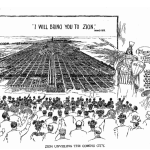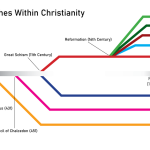[Here are some helpful resources and a helpful analysis by Larry Hurtado on the Emperor cult]
Roman Emperor Cult & Early Christianity: Some Recent Studies
by larryhurtado
In the ancient Roman setting in which the Christian movement emerged, the Emperor was a towering figure, successively from Augustus onward. I experienced a particular example of this myself a few years ago when visiting the Roman theatre in Orange. Above the stage area stood a large statue of the Emperor, signifying his superior status and role as patron of culture. And, at what we may regard as the opposite of “culture”, all gladiatorial contests were conducted under the Emperor’s patronage and dedicated to his honor.
Of still more significance for early Christians, the Emperor was treated widely as a divine figure, to whom temples, altars and priesthoods were dedicated. A recent book The Son of God in the Roman World: Divine Sonship in its Social and Political Context, by Michael Peppard (Oxford University Press, 2011) focuses on this, and particularly on the frequent application to the Emperor of the title “son of god”. I shall have more to say about Peppard’s book in a subsequent posting. But since the pioneering work of Adolf Deissmann in the early years of the 20th century, NT scholars have been interested in how the early Christians may have responded to the treatment of the Emperor as divine, and what impact this may have had on the way that they expressed their faith in Jesus. (Deissmann’s major book, Licht vom Osten, was translated as Light from the Ancient East, 1927, and has been reprinted, most recently by Hendrickson, 1995. It is a goldmine, still insufficiently drawn upon by NT students and scholars. Also still valuable is Deissmann, Bibelstudien, 1895, the English translation, Bible Studies, published 1901 and reprinted subsequently. Both draw upon Deissmann’s pioneering research on how the NT reflects the cultural setting in which it emerged.)
In the last several decades, however, our appreciation of Roman Emperor “cult” has been enhanced. For many of us, the work that sparked fresch interest and a more nuanced view of matters was S. R. F. Price, Rituals and Power: The Roman Imperial Cult in Asia Minor (Cambridge: Cambridge University Press, 1984). Also important is his analysis of how “god” language worked in the ancient Roman setting, and specifically how the Emperor could be regarded as “god”: “Gods and Emperors: The Greek Language of the Roman Imperial Cult.” Journal of Hellenic Studies 104 (1984): 79-95. Among the valuable points he made, Price effectively challanged some earlier notions that Roman emperor cult was a sham, simply a device of emperors to extend their political power, showing that people really did mean it in referring to the emperor as a “god” and/or “son of god”. But Price also showed that to grasp this requires us to engage how ancients used terms of deity, how they conceived of “gods”, which is very different from the conception that came to be accepted in Western culture largely under the influence of Christian theology.
Subsequent to Price’s influenctial study, there have been other valuable contributions, among them Ittai Gradel, Emperor Worship and Roman Religion (Oxford: Clarendon Press, 2002). Gradel also shows how ancient notions of the emperor’s divinity reflect an ancient view of “divinity” as a much more flexible and diverse category than moderns might think: “As I have argued, the question of absolute divineity, that is, of divine nature, was not very relevant in pagan antiquity. What was expressed in imperial cults was rather relative divinity, that is, divine status, and the absolute power it entailed in relation to the worshippers” (Gradel, p. 148).
One of the more recent works that occupied me during the Christmas break is a valuable multi-author collection of studies: Rome and Religion: A Cross-Disciplinary Dialogue on the Imperial Cult, eds. Jeffrey Brodd & Jonathan L. Reed (Atlanta: Society of Biblical Literature, 2011). The initial essay, and a key stimulus for the several symposia out of which the volume emerged, is Karl Galinsky, “The Cult of the Roman Emperor: Uniter or Divider?” (pp. 1-21). Galinksy usefully warns against over-simplifying things, especially as NT scholars seek to draw comparisons and contrasts between “emperor cult” and devotion to Jesus, and seek to explore how the NT writings may reflect the critical engagement of the Roman order by earliest Christians. I note with some slight amusement Galinsky’s somewhat cautionary view of some efforts by NT scholars to “search for coded evidence” of anti-imperial views in NT writings (p. 2). He also warns that early Christian “resistance cannot be isolated as reistance to Rome or the imperial cult alone,” but involved a wider “nexus of phenomena” that are often referred to in NT texts as “idolatry” (p. 6).
But in addition to Galinsky’s essay, there are a number of other contributions that make this volume very useful for anyone interested in an update, especially on how emperor cult is engaged by NT scholars as a factor in the religious/cultural environment of earliest Christianity.
Among studies by NT scholars, I particularly found impressive and informative Steven J. Friesen, Imperial Cults and the Apocalypse of John (Oxford University Press, 2001). Reflecting the judgement in the valuable work, Religions of Rome, by Mary Beard, John North and Simon Price (2 vols.; Cambridge University Press, 1998), that “there is no such thing as ‘the imperial cult’,” (1: 348), Friesen emphasizes in particular the distinctions between “provincial” imperial cults (under various emperors) and “municipal” imperial cults. In addition, Friesen offers a thoughtful (and appropriately sympathetic but critical) analysis of how the book of Revelation reflects one early Christian engagement with its religious setting.













